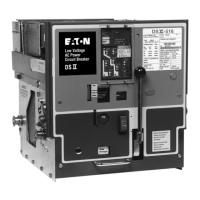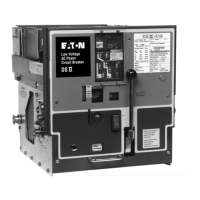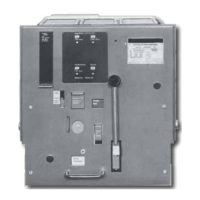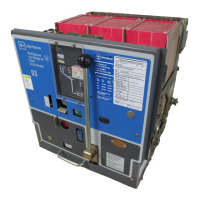from rotating by having a “flat” against the bottom of the
breaker horizontal top pan.
During reassembly, care must be taken to insure that the
two guide spacers are located in the slots of the top pan.
This permits the mechanism to float. Screws should be
tightened and then backed off one half turn to allow the
mechanism to float.
5-6 Lubrication
In general, the circuit breaker requires only moderate
lubrication at regular intervals. The use of a special lubri-
cant is required in a few places, and must be applied with
care. Only small quantities are needed. All excess must be
removed with a clean cloth to prevent any accumulation of
dust or dirt. Avoid getting any lubricant on insulation or other
electrical parts. Care must be taken to prevent any of the
molybdenum lubricant from reaching any current carrying
contact surface.
5-6.1 Lubrication Frequency
Under normal operating conditions, refer to Table 5.1 for the
recommended lubrication frequency for DSII circuit break-
ers by frame size. Special conditions, such as contaminated
environments, high temperatures and excessive humidity,
might dictate that a different schedule be considered.
NOTICE
ANY CIRCUIT BREAKER THAT HAS BEEN STORED SHOULD BE
OPERATED A MINIMUM OF FIVE TIMES BEFORE BEING PUT IN
SERVICE.
5-6.2 Lubricant Location
NOTICE
ALL PARTS OF THE LEVERING MECHANISM HAVE SUFFICIENT
LUBRICATION, AND SHOULD NOT REQUIRE ANY FURTHER ATTEN-
TION (FIGURE 5-7).
The following numbered lubrication point references corre-
spond to the numbers shown on Figures 5-8 through 5-12.
Molykote BR-2 Plus by Dow Corning (Molybdenum Disulphi-
de in Lithium Grease) or equivalent should be used sparingly
on the following:
1. Spring-charge indicator surface engaging with the cut-off
switch link
2. Cam surface operating the cut-off switch link
3. Pins on both ends of constraining link
4. Shunt trip moving armature surface
5. Curved surface of trip latch
6. Spring release moving armature surface
7. Several trip shaft points
8. Surface of cut-off switch link
9. Main spring pins on each end of crankshaft and fixed
ends
10. Rear face of oscillator
WARNING
BE CERTAIN THAT CIRCUIT BREAKER CONTACTS ARE OPEN AND
CLOSING SPRINGS DISCHARGED AFTER COMPLETING MAINTE-
NANCE ACTIVITIES. FAILURE TO DO SO COULD RESULT IN BODILY
INJURY.
Table 5.1 Lubrication Frequency
Breaker Type Interval *
(Breaker Cycles)
DSII-308, DSII-508, DSLII-308 1750
DSII-608, DSII-516, DSII-616, 500
DSII-620, DSLII-516, DSLII-620
DSII-632, DSII-840/850 250
* Breaker Cycle - one no load open/close operation.
Effective July 2010
Instructional Book IB694C694-03
59
EATON CORPORATION www.eaton.com

